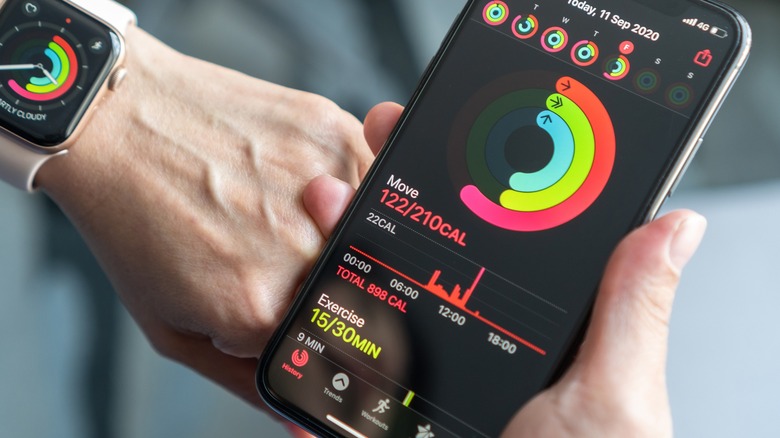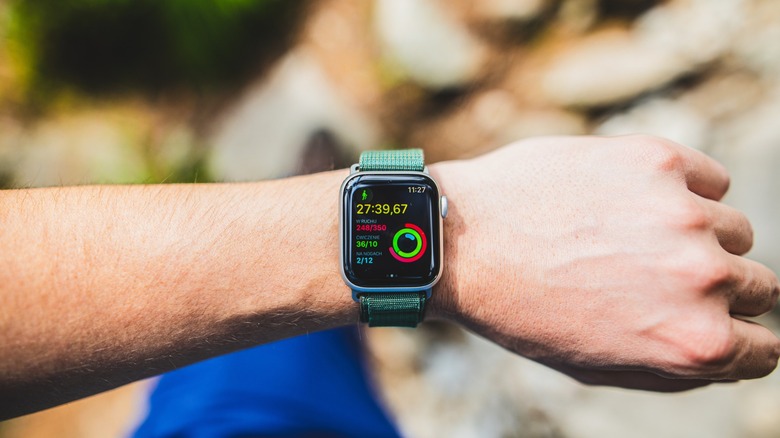How Does The Apple Watch Calculate Calories Burned, And Is It Accurate?
The Apple Watch is a versatile device that goes beyond just being an extension of the iPhone. Though many of its features do supplement the most basic functions of a smartphone, Apple designed its smartwatch to also aid in promoting personal health. Among the calculated health readings is the number of calories burned. While you may be inclined to use this number as a baseline for determining whether you exercised enough to earn a cheat day, you should carefully consider whether the Apple Watch is even offering an accurate figure.
We've known for some time that the nutritional labels on our food can be inaccurate. In fact, the FDA allows for a 20% discrepancy between the declared and actual value. That may not be a lot, but it can add up over a day of eating, so it's even more imperative that you're more accurately calculating the calories you're burning.
To gauge the device's accuracy, we'll first start by breaking down how it does what Apple claims it can do. Calculating the number of calories burned must be a complicated process. Unlike a heart rate monitor, which reads a physical change in your body, a calorie counter is essentially gauging energy expenditure based on different factors.
How does the Apple Watch calculate calories burned?
According to Apple, the Apple Watch bases your calories burned on personal information you provide while setting up your health details in the iPhone's Watch app. You'll need to provide your age, gender, height, and weight to ensure the reading is as accurate as possible.
Unfortunately, that's as detailed as Apple gets in explaining how its calorie counter works. Though it explores the importance of activity in reaching your desired caloric burn, it doesn't touch on how its devices achieve this number. For that, we can look to Fitbit, a leading provider of fitness wearables, where we finally start seeing things like basal metabolic rate (BMR), a core component of calculating calories burned.
Apple may not state it outright, but the personal information you provide is typically used to determine your BMR or the rate at which your body burns calories when at rest. What Apple does confirm is that the user's heart rate is one of several factors used to measure activity levels. This could mean that, like the Fitbit and similar devices, readings like your blood circulation, pulse, and heart rate will factor into the number of calories burned.
What we know for sure is that all of this happens on the backend, and the Apple Watch simply presents you with a number. That leaves us wondering: is that number accurate?
Is the Apple Watch's calorie counter accurate?
While Apple states that providing accurate information will allow your Apple Watch to accurately count your calorie burn, it's important to understand that 100% accuracy is never a guarantee.
Health and fitness content creator Shervin Shares put the Apple Watch and similar wearables through a series of tests to determine their accuracy. Working in two sports labs in New York City, Shervin participated in a series of three metabolic tests, each measuring calorie burn based on the expenditure of carbon dioxide. He then compared those results with the Apple Watch, a Garmin wearable, Whoop's fitness tracker, and the Oura Ring.
The tests showed that not only was the Apple Watch inaccurate, but none of the fitness trackers were all that reliable. For example, during the first test, the center registered a burn of about 323 calories, while the Apple Watch displayed 550 calories. After the second test, the Apple Watch again overestimated the calories burned, though this time only by 57 calories. Across all three tests, there wasn't one consistent variable that suggested one device was better suited for determining caloric burn.
In a more official capacity, researchers at the Stanford University School of Medicine found that wearables, in general, are poor measures of energy expenditure. In a 2017 study of seven devices, including the Apple Watch, the team determined that the most accurate devices were still off by around 27%. The least accurate was as bad as 93%.
How can you more accurately calculate calories burned?
That's not to say there isn't an accurate way to measure your calorie burn. It just isn't a device you wear on your wrist, finger, or arm. While laboratories and testing centers will measure how much carbon dioxide and oxygen are exchanged in an individual's breath, Stanford University engineers believe the legs may be the answer for consumer-friendly devices.
A 2021 paper published by Standford researchers found that two sensors placed at the thigh and shank of a leg generated more accurate results than the wrist-based devices. According to associate professor of aeronautics and astronautics Mykel Kochenderfer, the more accurate reading comes from the fact that most of the energy being expended during activities like walking and running is coming from your legs. While still not perfect, the system decreased the rate of error to an average of 13%.
All of this is not to say you can't use your Apple Watch to determine your caloric burn. You just need to be cautious and use your wearable as a baseline to understand your progress and not a scientifically accurate reading to gauge how many calories you can intake.



